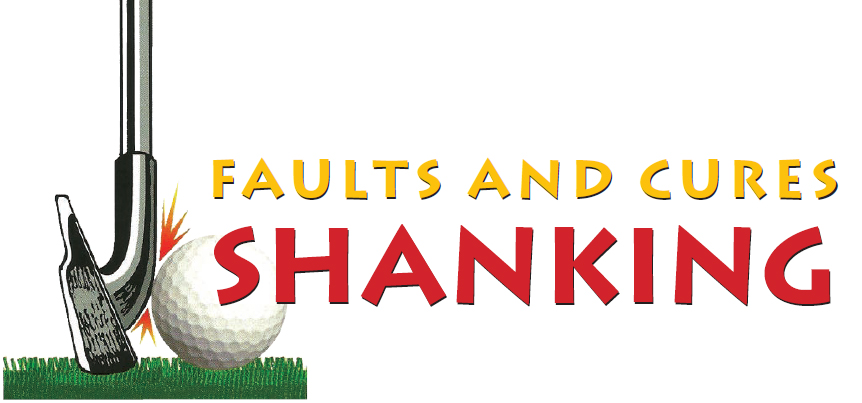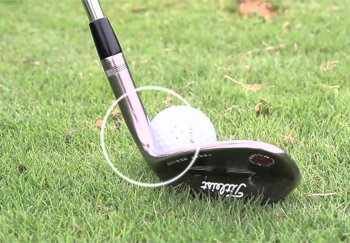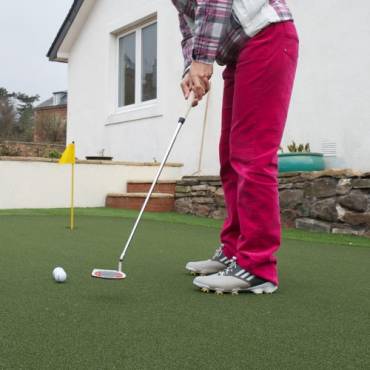 At some point in our golfing life we have all ‘had a shank’ but for some this has become so common it has even driven golfers to give up the game temporarily or permanently. When shanking manifests it becomes a psychological issue that can rarely be sorted by the victim. For a golf coach who is faced with a pupil with a serious version it is one of the hardest lessons to improve the pupil during that first session. On a positive aspect I consider the affliction a challenge to us both and therefore look at the subject as a problem shared. To start with…..at what level does one shank?
At some point in our golfing life we have all ‘had a shank’ but for some this has become so common it has even driven golfers to give up the game temporarily or permanently. When shanking manifests it becomes a psychological issue that can rarely be sorted by the victim. For a golf coach who is faced with a pupil with a serious version it is one of the hardest lessons to improve the pupil during that first session. On a positive aspect I consider the affliction a challenge to us both and therefore look at the subject as a problem shared. To start with…..at what level does one shank?
- Level one – you shank occasionally but it doesn’t bother you
- Level two – you shank quite often and it starts to play on your mind but has little impact on the rest of your game
- Level three – it is at the forefront of your mind to the extent that you expect it to happen every time you use an iron together with it ruining your confidence with the rest of your game even though you can’t shank a wood or a putter and additionally your personal life outside golf is dramatically affected
 There are various remedies that can lessen ‘shanking’ even to the point of eradicating it once and for all but I consider a person’s ‘state of mind’ as a huge factor in the equation. An adult understands the meaning of the word ‘fear’ moreso than a child recalling life events that created anxiety .
There are various remedies that can lessen ‘shanking’ even to the point of eradicating it once and for all but I consider a person’s ‘state of mind’ as a huge factor in the equation. An adult understands the meaning of the word ‘fear’ moreso than a child recalling life events that created anxiety .
Shanking creates one of these moments making a golfer anxious, irrational and panic can ensue. First and foremost during a lesson l try to get the pupil to understand at what level of the three stages they are at. Quite often prior to me explaining the content of the three stages they don’t always admit to how seriously they are suffering.
My belief is shanking ‘has to be managed’ from the moment prior to your preparation before you have a practice swing to the moment you are executing the actual swing over the ball. Your practice swing could easily be a swing that doesn’t resemble the same swing you want to use over the ball so in your mind change the name of your practice swing to a ‘rehearsal swing’ therefore you are trying to do the same with every swing whether with or without a ball.
When executing a rehearsal swing make sure you are happy with its outcome before attempting the same action over the ball…if you are not stand away and start again.
Theoretically, you only need one rehearsal swing before you attempt a swing to hit the ball. Do not attempt to hit a ball if you become distracted or have not had enough practice swings before your first shot of the day. Please also bear in mind trying to eradicate a serious bout of the shanks on the golf course is extremely difficult ….it needs repetition on the practice area. Shanking can  be caused by many reasons but one important common denominator is at the point of impact the ball has made contact with the heel area of the clubface. A myth l often come across is golfers believe you always shank with an open clubface….this is categorically not true….you can shank with a square and closed face too. Further to this a golfer can shank on the downswing with either an ‘out to in’ swingpath or an ‘in to out’swingpath.
be caused by many reasons but one important common denominator is at the point of impact the ball has made contact with the heel area of the clubface. A myth l often come across is golfers believe you always shank with an open clubface….this is categorically not true….you can shank with a square and closed face too. Further to this a golfer can shank on the downswing with either an ‘out to in’ swingpath or an ‘in to out’swingpath.
So how do l really stop a pupil shanking?
1 – create a practice environment where you can’t easily be distracted by others or anything
2 – only chip the ball with a wedge a few yards to start with making your task easier
3 – make sure not only that the ball strike is out of the middle of the clubface but it is correctly struck consistently before you increase the distance of your swing and flight….ideally achieve at least 7 out of 10 of your last shots struck correctly and out of the middle of the clubface at the same time before you consider increasing the distance….ideally no more than an extra 10 yards at a time
4 – improve your posture by not crouching at address
5 – keep your wrists firm throughout your initial short starting swing with your hands slightly forwards of the clubhead at address
6 – connect your arms to your body via your elbows bedded in to your tummy so you feel there is barely any room to swing…keeping this connection throughout is the secret
7 – do not address the ball in the toe end of the clubface as you will be encouraging the club to move further from the body at impact to connect with the middle of the clubface increasing a swing that overreaches and so improving the chances of shanking….a ball struck from the toe end of the club is not a cure for shanking as it creates a poor feel
8 – to start with don’t swing further than four feet back and through (edge of a range mat) therefore limiting your distance to approximately 20 to 30 yards moreover keep your arms connected to your tummy throughout your swing and make sure you complete the movement with your grip still in tact
9 – keeping your arms connected means the club will be the same distance from your body at impact as it was when you started your swing…providing you started with the ball in the centre of the clubface you will make contact at impact with the ball struck out of the centre again…try not to move your weight during your short swing keeping it stacked in favour of the front foot via a 60/40 distribution
10 – remember….the correct strike at impact is a downward angle creating the ball struck first then the ground immediately after
11 – at some point via better results and improved confidence, you will look to lengthen your swing throughout, but be aware that when the club moves further back and through your arms will naturally want to disconnect from your tummy, which is fine but try and reconnect with your tummy when you enter the impact area (roughlythe width of your hips/shouldersjust before and after impact.
Now you’re on your way to playing better golf and restoring your confidence do not ‘run before you can walk’ i.e. don’t force extra distance in to the equation too early. l’d much rather see a golfer hit 50 correct connections at a short distance before they move on. Practicing with plastic balls is a helpful way of encouraging an impact strike feel which is similar each time whether out of the clubface or out of the heel and therefore lessens the fear factor.




